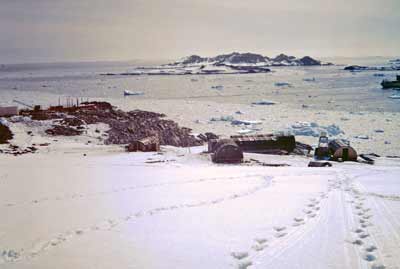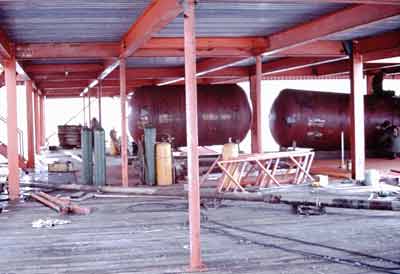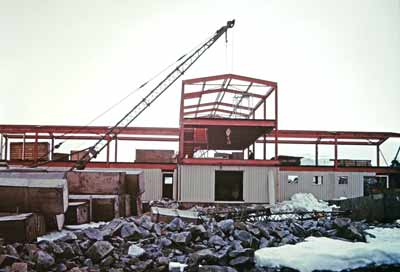Palmer Station Completion 1967-68
|
The 1967 winter isolation at Palmer Station did not end until 21 December when the Coast Guard icebreaker Southwind, arrived from Punta Arenas, bringing construction personnel of CBU 201 Platoon Alpha, some materials, and replacements for the winterovers. Southwind visited several other foreign stations in the Peninsula area before returning to Palmer on 7 January 1968, in time to meet the cargo vessel Wyandot on the 10th. Both vessels left Palmer on the 13th...the winterovers departed on Wyandot for...McMurdo (!). Southwind would make FIVE (!) more trips between South America and Palmer Station in late season--first arriving at Palmer on 1 February, departing for Ushuaia on 3 February on a medevac mission, returning to Palmer on 8 February, heading to Punta Arenas on the 10th to pick up spare parts and last-minute construction materials, waiting there between the 15th and 20th (not everything had arrived), returning briefly to Palmer on 23 February and heading back to PA the same day. Southwind left PA on the 28th and returned to Palmer on 3 March after a failed attempt (due to weather) to do aerial reconnaissance of Deception Island. The ship headed back north on the 11th, this time to pick up more construction punch list material...as well as RADM Abbott, NSF's Phil Smith, and other military and civilian dignitaries who would attend the station dedication. Southwind spent 3 days at PA before heading south on the 17th, arriving at Palmer Station on the 20th...just in time for the dedication. Meanwhile, Glacier had arrived at Palmer on the 16th at the conclusion of a Weddell Sea oceanographic project. By the time Southwind arrived, the new station had already been occupied. Boats and helicopters from both icebreakers assisted in the transfer of cargo, material, and people from Old Palmer to the new station. | |
| The longer tank (to the right) right is the one in the above photo...it contained firefighting water which fed several fire hoses in Biolab and included a CO2 system to pressurize the firewater if an alarm was sounded. This tank was removed in 2000 and replaced with a stainless steel tank (outside/insulated) that supplied sprinkler systems. The tank at left was epoxy lined and contained potable water. In the late 80s during its annual cleaning (with long vacuum hoses) we noticed that the epoxy lining was deteriorating and there was rust present. Although the painter offered to go in, clean off the rust, and recoat the areas...the manway was extremely small (and there was only one of them). And we didn't have any epoxy coating. Anyway, I insisted that no one go inside of the tank for safety reasons, and the following season we cut up the tank, removed it, and replaced it with two vertical food-safe plastic tanks. I don't know if they are still there. | |
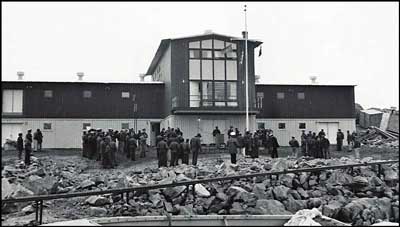 And things were finished! Here's a photo of the station during the dedication/commissioning ceremony on 20 March 1968. More coverage of the dedication is here. | |
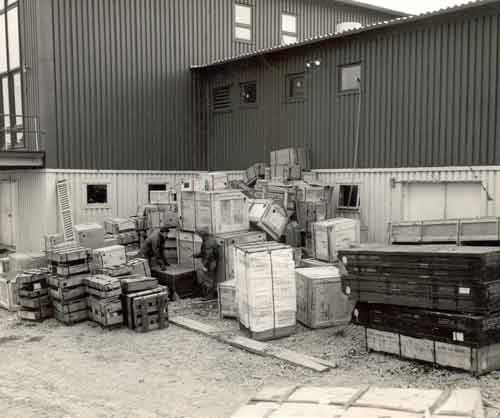 I'm unsure when the photo at left (CB) was taken, but it probably shows retrograde cargo outside of the Biolab...including several crated Jamesway sections, perhaps from the Seabee camp. As both icebreakers Glacier and Southwind had planned to depart Palmer early on 21 March (the day after the dedication), this cargo must have been loaded before the ceremony. The departures were delayed a bit after Southwind encountered a rock pinnacle (!?) and ran aground. After inspection, both vessels headed north later that day...carrying the CBU 201 construction crew, the DV's, and the rest of the summer station crew. I find it extremely impressive that the Seabee platoon was able to essentially erect, close in, finish, and turn over a three-story research building--including the power plant and desal units...in FOUR months! Credits...almost all of the photos are from Jim Turner, a CBU 201 welder who was around for both of the Palmer Station construction seasons. He graciously shared his photos upon the 50th anniversary of the Palmer Station dedication in April 2018. The three photos labeled (CB) were shared by the U.S. Navy Seabee Museum. This page was updated May 2019. | |

